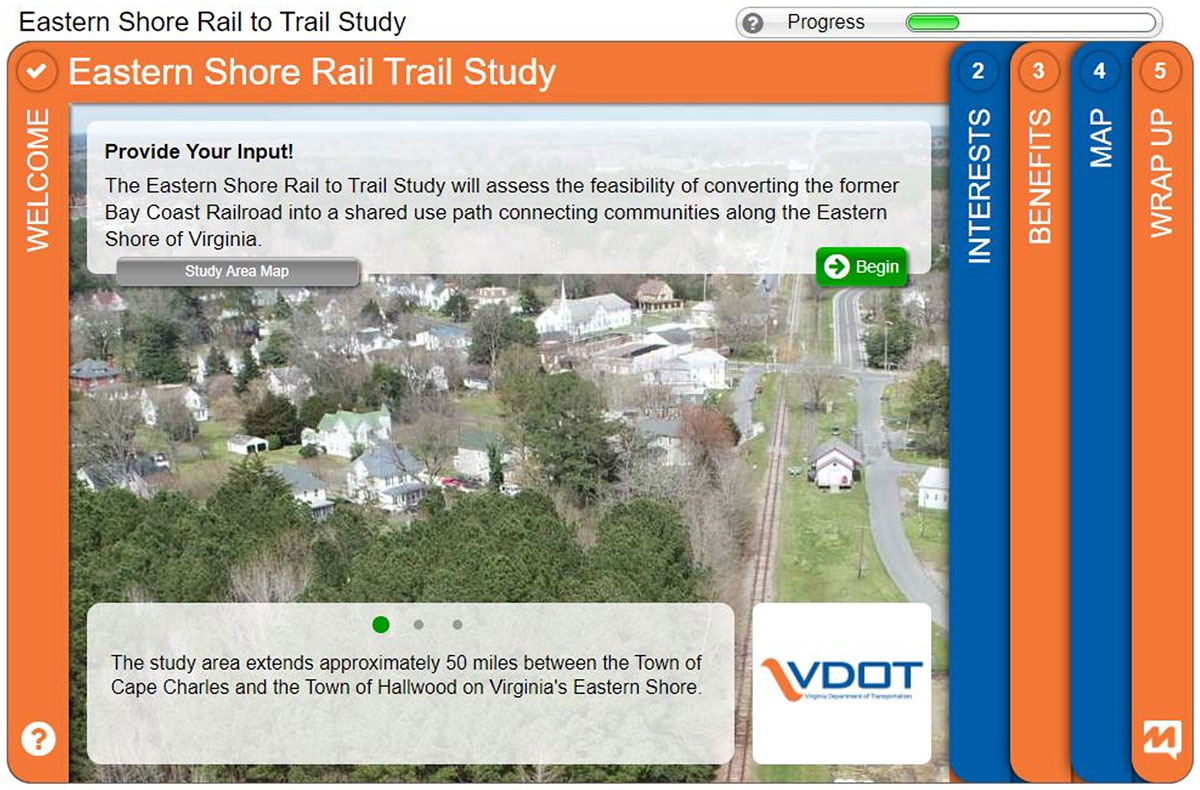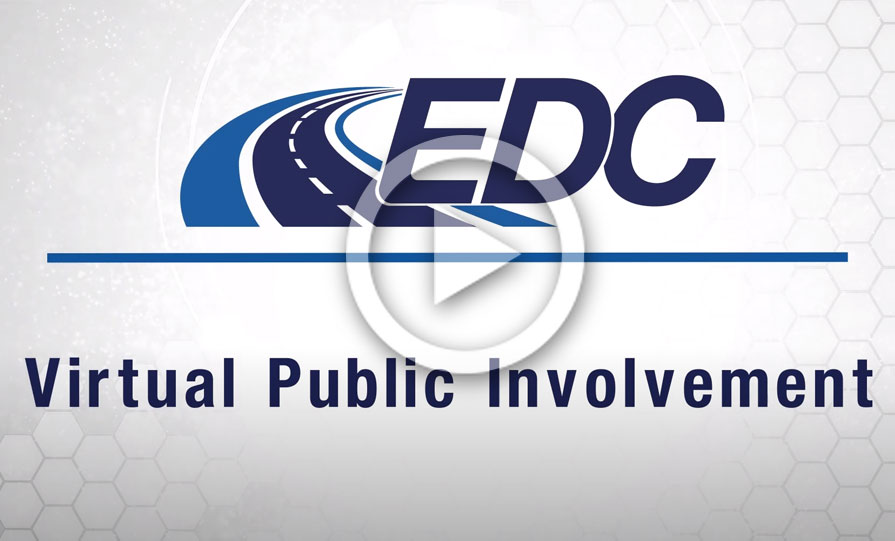June 24, 2021
Innovation of the Month:
Virtual Public Involvement
While many States use virtual public involvement (VPI) to supplement public meetings or gather public input, one goal of the VPI team in EDC-6 is to support and encourage States to expand its usage and integrate VPI techniques into regular business practices. The Virginia Department of Transportation (VDOT) built upon its experiences gained during EDC-5 and institutionalized VPI in this way.
Even before 2020, VDOT used VPI to enhance public engagement in required face-to-face public meetings. Over the last year VPI was pushed to the forefront in cases where in-person meetings were not required. VDOT wanted to be sure participants would have the opportunity to provide meaningful input on all projects regardless of whether it was required. VPI allowed the State to continue with planning and project development during this time.
To enable these meetings to continue, VDOT incorporated a range of tools, including online surveys, virtual meetings, and more into its planning studies and outreach efforts. VDOT used VPI for virtual design hearings using a wide range of platforms and promoted meetings on social media to reach wider audiences.

For project development, VDOT relies heavily on its resident engineers in determining which VPI strategies to implement, as they are VDOT's "boots on the ground." They understand their community and the level of public involvement that may be needed for a design hearing related to a specific project. That knowledge, in conjunction with working with the Environmental Division and communications professionals, helps to establish the communication plan.
VDOT has used VPI on a range of projects, including smaller, local corridor studies, larger interstate projects, statewide studies, such as statewide commuter surveys, and alternative transportation studies, such as bicycle and pedestrian and trail planning studies. VDOT worked with federal partners to outline a process for using virtual public involvement, either as a supplement for the NEPA-required public hearings, or to use virtual public involvement to meet Virginia code with a virtual public design hearing. VDOT institutionalized VPI by formalizing these processes as an addendum to its public involvement manual and has issued guidance that will be updated with lessons learned. VDOT also released guidance to its staff on the virtual toolbox available to them, and how to approach each project and develop individual communication plans working with local agency personnel to effectively reach stakeholders. VDOT also developed forms its staff can use to request certain VPI tools, templates for presentations, and technical requirements for videos and presentations to ensure consistency and quality control.

Watch this spotlight video to learn more about VPI. If you have additional questions, please contact Lana Lau, FHWA Office of Project Development & Environmental Review, Carolyn Nelson, FHWA Office of Project Development & Environmental Review, or Jill Stark, FHWA Office of Planning, Stewardship, & Oversight.
Bridge Inspection with Unmanned Aerial Systems Taking Off Nationwide
Unmanned aerial systems (UAS) are impacting, and in some cases completely changing, how transportation agencies conduct business. As prices for UAS lower and the awareness of the technology continues to spread, the overall use of UAS for infrastructure inspection and condition monitoring activities continues to increase. One of the more promising use cases of UAS is supporting inspection of in-service bridges.
The agility and overall capabilities of UAS can be leveraged to alleviate several barriers or challenges inherent in the bridge inspection process, including the high cost and limited availability of specialized access equipment, limited inspector access to portions of a bridge, and the cost and safety implications of the traffic restrictions needed for some inspections.
In the tech brief, "Use of Small Unmanned Aerial Systems for Bridge Inspection," learn more about this use case, including UAS advantages, regulatory information, considerations to make before using UAS, and limitations of using UAS for supporting bridge inspection. Learn answers to questions such as what UAS platform, sensors, controls, and software may be required to effectively use UAS for bridge inspection.
To learn more about UAS bridge inspection, contact James Gray, FHWA Office of Infrastructure, or John Haynes, FHWA Utah Division.
The Business Case for Crowdsourcing: Seven Rapid-Fire Success Stories
Crowdsourcing turns transportation system users into real-time sensors on system performance, providing low-cost, high-quality data on traffic operations, roadway conditions, traveler information, and more. This technology also enables proactive operational strategies and applications to optimize the use of existing roadway facilities and save operator staff time.
An on-demand Crowdsourcing webinar features seven successes in the use of crowdsourced data presented in a rapid-fire format. Representatives from Missouri, Colorado, Delaware, Maine, and Indiana DOTs, the North Central Texas Council of Governments, and the Lake County (Illinois) Division of Transportation highlight how their agencies benefitted from using crowdsourced data for traffic incident, road weather, traffic signal, maintenance, traveler information, and project prioritization functions.
View the webinar on-demand to learn more about the business case for Crowdsourcing. If you have additional questions on Crowdsourcing, contact James Colyar, FHWA Office of Operations, Greg Jones, FHWA Resource Center, or Ralph Volpe, FHWA Resource Center.
Stay Up to Date on the EDC Innovations That Interest You Most
EDC teams are always on the move! If you blink, you could miss out on important webinars, case studies, tools, videos, and more. To never miss information for the EDC innovations that interest you most, visit the subscription page and select the topics you'd like to receive updates on directly from the teams that coordinate them.
Recent bulletins:
Collaborative Hydraulics: CHANGE – 6/17/21
Focus on Reducing Rural Roadway Departures – 6/14/21
NextGen TIM – 6/8/21
2021 STIC Excellence Award Nominations
Nominations are open through July 1 for the 2021 State Transportation Innovation Council (STIC) Excellence Award, which recognizes a STIC that has made significant impact toward fostering a strong culture for innovation. Past awardees have been recognized for a variety of efforts and initiatives, representing agencies from across the Nation that put innovation at the forefront. FHWA and the American Association of State Highway and Transportation Officials Innovation Initiative partnered to sponsor the award to promote innovations and to recognize excellence within the STICs.
See the 2021 STIC Excellence Award Nomination form for more details and visit the STIC Excellence Award webpage to read about past recipients. If you have additional questions, contact Sara Lowry, National STIC Network & Incentive Program Coordinator.
About EDC
Every Day Counts, a State-based program of the Federal Highway Administration’s Center for Accelerating Innovation, works with State, local, and private sector partners to encourage the adoption of proven technologies and innovations to shorten and enhance project delivery.
Recommended Citation:
U.S Department of Transportation, Federal Highway Administration
EDC News; June 24, 2021
Washington, DC
https://doi.org/10.21949/1521840


